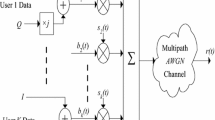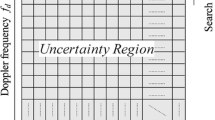Abstract
In direct sequence code division multiple access (DS-CDMA) systems, signal acquisition is necessary before communication can commence. Recent work has shown that the problem of acquisition may be even more restrictive than the problem of error control in limiting the capacity and performance of these systems. Passive matched filters and parallel search schemes have been shown to be able to acquire signals rapidly, but they do so at the cost of high or prohibitive complexity. In contrast, straight serial search schemes have lower complexity but acquire the signal much more slowly. In this paper, we studyhybrid active correlation schemes that provide flexibility in the trade-off between acquisition speed and complexity. These techniques test several phases concurrently and either decide that a particular phase is correct, in which case the decision is verified by a binary hypothesis test, or that none of the phases are correct, in which case another group of phases is tested. Two new hybrid acquisition schemes are presented; the first is based on a fixed-sample-size weighted MAP test, and the second is based on anM-ary sequential hypothesis test called MSPRT. It is shown that the weighted MAP-based scheme hypothesis test called MSPRT. It is shown that the weighted MAP-based scheme outperforms a standard MAP-based scheme. It is also shown that considerable performance gain can be obtained using sequential testing. In particular, it is shown through numerical examples that MSPRT-based schemes are several times faster than corresponding fixed-sample-size schemes.
Similar content being viewed by others
References
U. Madhow and M. B. Pursley, Acquisition in direct-sequence spread-spectrum communication networks: An asymptotic analysis,IEEE Transactions Information Theorey, Vol. 39, No. 3, pp. 903–913, 1993.
R. E. Ziemer and R. L. Peterson,Digital Communications and Spread Spectrum Systems, Macmillan, New York, 1985.
M. K. Simon, J. K. Omura, R. A. Scholtz, and B. K. Levitt,Spread Spectrum Communications, Vol. III, Computer Science Press, Rockville, MD, 1985.
Y. T. Su, Rapid code acquisition algorithms employing PN matched filters,IEEE Transactions Communications, Vol. COM-36, No. 6, pp. 724–733, 1988.
K. K. Chawla and D. V. Sarwate, Parallel acquisition of PN sequences in DS/SS systems,IEEE Transactions Communications., Vol. 42, No. 5, pp. 2155–2164, 1994.
L. B. Milstein, J. Gevargis, and P. K. Das, Rapid acquisition for direct sequence spread spectrum communications using SAW convolvers,IEEE Transactions Communications, Vol. 33, No. 7, pp. 593–600, 1985.
U. Cheng, Performance of a class of parallel spread-spectrum code acquisition schemes in the presence of data modulation,IEEE Transactions Communications, Vol. 36, No. 5, pp. 596–604, 1988.
U. Cheng, W. Hurd, and J. Statman, Spread spectrum code acquisition in the presence of Doppler shifts and data modulation,IEEE Transactions Communications, Vol. 38, No. 2, pp. 241–250, 1990.
L. D. Davisson and P. G. Flikkema, Fast single-element PN acquisition for the TDRSS MA system,IEEE Transactions Communications, Vol. 36, No. 11, pp. 1226–1235, 1988.
E. A. Sourour and S. C. Gupta, Direct-sequence spread-spectrum parallel acquisition in a fading mobile channel,IEEE Transactions Communications, Vol. 38, No. 7, pp. 992–998, 1990.
E. A. Sourour and S. C. Gupta, Direct-sequence spread-spectrum parallel acquisition in nonselective and frequency-selective Rician fading chennels,Journal of Selected Areas in Communications, Vol. 10, No. 3, pp. 535–544, 1992.
K. K. Chawla and D. V. Sarwate, Acquisition of PN sequences in chip synchronous DS/SS systems using a random sequence model and the SPRT,IEEE Transactions Communications, Vol. 42, No. 6, pp. 2325–2334, 1994.
A. Polydoros and C. L. Weber, A unified approach to serial search spread-spectrum code acquisition. I, II,IEEE Transactions Communications, Vol. COM-25, No. 5, pp. 542–560, 1984.
Y.-H. Lee and S. Tantaratana, Acquisition of PN sequences for DS/SS systems using a truncated sequential probability ratio test,Journal of the Franklin Institute, Vol. 328, No. 2/3, pp. 231–248, 1991.
C. W. Baum and V. V. Veeravalli, A sequential procedure for multihypothesis testing,IEEE Transactions Information Theory, Vol. 40, No. 6, pp. 1994–2007, November 1994.
D. V. Sarwate and M. B. Pursley, Crosscorelation properties of pseudorandom and related sequences,Proc. IEEE, Vol. 68, pp. 593–619, 1980.
H. V. Poor,An Introduction to Signal Detection and Estimation, Springer-Verlag, New York, 1988.
C. L. Weber,Elements of Detection and Signal Design, Mc-Graw-Hill, New York, 1968.
Author information
Authors and Affiliations
Rights and permissions
About this article
Cite this article
Veeravalli, V.V., Baum, C.W. Hybrid acquisition of direct sequence CDMA signals. Int J Wireless Inf Networks 3, 55–65 (1996). https://doi.org/10.1007/BF02106662
Issue Date:
DOI: https://doi.org/10.1007/BF02106662




